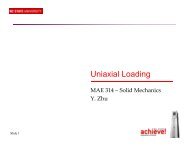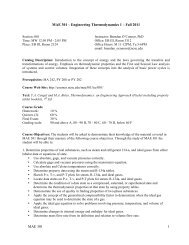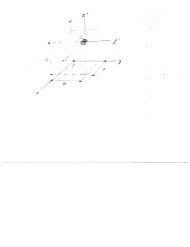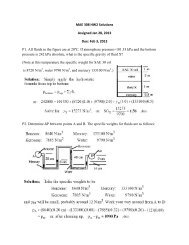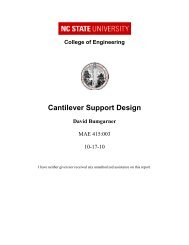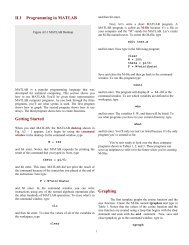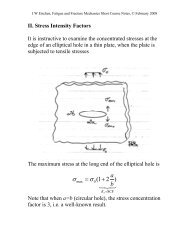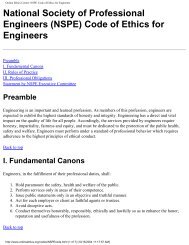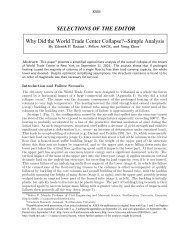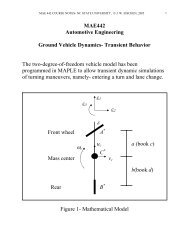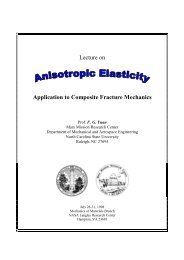B di III ending III: Deflection of Beams
B di III ending III: Deflection of Beams
B di III ending III: Deflection of Beams
Create successful ePaper yourself
Turn your PDF publications into a flip-book with our unique Google optimized e-Paper software.
Ben<strong>di</strong>ng <strong>III</strong>:<strong>Deflection</strong> <strong>of</strong> <strong>Beams</strong>MAE 314 – Solid MechanicsY. Zhu
Introduction• Up to now, we have been primarily calculating normal andshear stresses.• In this lecture, we will learn how to formulate the deflectioncurve (also known as the elastic curve) <strong>of</strong> a beam to duetransverse loa<strong>di</strong>ng.Slide 2
Differential Equation <strong>of</strong> <strong>Deflection</strong>ρd θ= dsdθ 1=ds ρRecall from Ch. 4 that1/ρ is the curvature <strong>of</strong>the beam.ydsdyθdxSlope <strong>of</strong> the deflection curvedydxdxds= tanθθ= cosθdyds= sinθSlide 3
Assumptions• Assumption 1: θ is small.– 1.dθ1 dθds≅ dx ⇒ds= ρ ≅ dxdydθ d 2 y– 2. = tanθ≅ θ⇒=2dxdx dx⇒21 d y=ρ2dx• Assumption 2: Beam is linearly elastic.1=ρ• Thus, the <strong>di</strong>fferential equation for the deflection curve is:2d y2dx=MEIMEISlide 4
Diff. Equations for M, V, and w• Recall :dVdxdM= −w= Vdx• So we can write:2d yEI =2dxM3d yEI = V3dxEI4d y4dx=−w• <strong>Deflection</strong> curve can be found by integrating– Ben<strong>di</strong>ng moment equation (2 constants <strong>of</strong> integration)– Shear-force equation (3 constants <strong>of</strong> integration)– Load equation (4 constants <strong>of</strong> integration)• Chosen method depends on which is more convenient.Slide 5
Boundary Con<strong>di</strong>tions• Sometimes a single equation is sufficient for the entire length <strong>of</strong> thebeam, sometimes it must be <strong>di</strong>vided into sections.• Since we integrate t twice there will be two constants t <strong>of</strong> integration ti foreach section.• These can be solved using boundary con<strong>di</strong>tions.– <strong>Deflection</strong>s and slopes at supports– Known moment and shear con<strong>di</strong>tionsSlide 6
Boundary Con<strong>di</strong>tions cont’d• Continuity con<strong>di</strong>tions:– Displacement continuityy( C)y ( C)AC=CB– Slope continuitySection AC: y AC (x) Section CB: y CB (x)dyACdyCB( C)=θAC (C)=(C)=θ CB(C)dydxdx• Symmetry con<strong>di</strong>tions:dx= 0Slide 7
Example Problem 1The cantilever beam AB is <strong>of</strong> uniform cross section and carries a loadP at its free end A. determine the equation <strong>of</strong> the elastic curve and thedeflection and slop at A (Example 9.01 in Beer’s book (P535)).Slide 8
Slide 9
Example Problem 2For the beam and loa<strong>di</strong>ng shown, (a) express the magnitude andlocation <strong>of</strong> the maximum deflection in terms <strong>of</strong> w 0 , L, E, and I.(b) Calculate late the value <strong>of</strong> the maximum m deflection, assuming that beamAB is a W18 x 50 rolled shape and that w 0 = 4.5 kips/ft, L = 18 ft, andE = 29 x 10 6 psi.Slide 10
Slide 11
Statically Indeterminate <strong>Beams</strong>• When there are more reactions than can be solved usingstatics, the beam is indeterminate.• Take advantage <strong>of</strong> boundary con<strong>di</strong>tions to solve indeterminatei tproblems.Problem:x=0, y=0x=0, θ=0x=L, y=0Number <strong>of</strong> reactions: 3 (M A , A y , B y )Number <strong>of</strong> equations: 2 (Σ M = 0, Σ F y = 0)One too many reactions!Ad<strong>di</strong>tionally, if we solve for the deflection curve,we will have two constants <strong>of</strong> integration, whichadds two more unknowns!Solution: Boundary con<strong>di</strong>tionsSlide 12
Statically Indeterminate <strong>Beams</strong>Problem:x=0, y=0x=0, θ=0x=L, y=0x=0, θ=0Number <strong>of</strong> reactions: 4 (M A , A y , M B , B y )Number <strong>of</strong> equations: 2 (Σ M = 0, Σ F y = 0)+ 2 constants <strong>of</strong> integrationSolution: Boundary con<strong>di</strong>tionsSlide 13
Example Problem 3• Determine the reactions at the supports for the prismaticbeam shown below (Example 9.05 in Beer’s book).Slide 14
Slide 15
Example Problem 4For the beam shown determine the reaction at the roller support whenw 0 = 65 kN/m.Slide 16
Slide 17
Method <strong>of</strong> Superposition• <strong>Deflection</strong> and slope <strong>of</strong> a beam produced by multiple loadsacting simultaneously can be found by superposing thedeflections produced by the same loads acting separately.• Reference Appen<strong>di</strong>x E in Craig’s book (Beam <strong>Deflection</strong>s andSlopes)• Method <strong>of</strong> superposition can be applied to staticallydeterminate and statically indeterminate beams.Slide 18
Superposition cont’d• Consider the problem on the right.• Find reactions at A and C.• Method 1: Choose M C and R C asredundant.• Method 2: Choose M C and M A as redundant.Slide 19
Example Problem 5For the beam and loa<strong>di</strong>ng shown, determine (a) the deflection at C, and(b) the slope at end A.Slide 20
Slide 21
Example Problem 6For the beam shown, determine the reaction at B.Slide 22
Slide 23
Example Problem 4The overhanging steel beam ABC carries a concentrated load P at end C.For portion AB <strong>of</strong> the beam, (a) derive the equation <strong>of</strong> the elastic curve,(b) determine the maximum deflection, (c) evaluate y max for the followingdata:W 14x68 I = 723 in 4 E = 29x10 6 psiP = 50 kips L = 15 ft = 180 in. a = 4 ft = 48 in.(sample problem 9.1 in Beer’s book (p. 542))Slide 24




